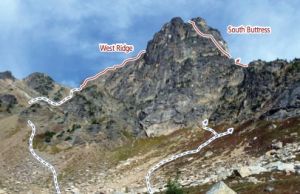West Ridge, Cutthroat Peak III+ 5.7 |
||
Washington Pass, Washington, USA | ||
| ||
|
Avg time to climb route: 2-5 hours
Approach time: 2.5-4 hours Descent time: 2.5-4 hours Number of pitches: 9 Height of route: 5,000' Overview
The West Ridge has some interesting climbing that is very moderate and exposed. There are some slightly loose sections that are a little run out, but the crux is short and well-protected. It is an adventurous “off the beaten path” route known for known for its fun, exposed and easy traverses.
Photos
- View all 2 photos of West Ridge as: Thumbnails | Slideshow
Climber Beta on West Ridge
Find other routes like
West Ridge
Route History
This was first climbed in 1937 by W.K. Davis, Kenneth Adams, and Raffi Bedayn, all Californians and Sierra Club members. They were well trained on Yosemite granite and bagged some of the prime first ascents in the area, shocking locals and making a few enemies in the process. They hoped and believed they had the first ascent of Liberty Bell, but their map only loosely labeled the whole massif as Liberty Bell, so they climbed the Southwest Couloir of what turned out to be the South Early Winters Spire. They said, “all the other peaks looked extremely difficult on all sides.” Locals argued that these so-called Yosemite-trained climbers might have bagged the tallest peak, but by the only non-technical route in the whole Liberty Bell massif.Route Strategy
This is not climbed often and it is unlikely you will have to share the route with another party, even on a busy weekend. One of the biggest drawbacks to the West Ridge is the approach, which is long and steep with a fair bit of loose sandy walking. The West Ridge approach is slightly easier and much more pleasant earlier in the season when large portions of it are covered in snow. Because you descend the route, you can wear boots to the base and climb the ridge in your rock shoes, leaving your heavier footwear at the bottom.The West Ridge has a reputation for slightly loose rock. This is not undeserved, but the rumors are a little blown out of proportion. There is no pitch on the West Ridge as loose as Pitch 1 gaining the crest on the North Ridge. There is some poor protection mixed with some tricky route finding on the first two pitches, but these pitches are fairly moderate and never harder than 5.2 if you find the best route. After the first two pitches, the next part of the route is mostly 2nd-4th class fun climbing on a broad, well defined ridge. Stay generally on top of the ridge or slightly to the right (south) side of the crest for several hundred feet until the ridge steepens again. This section is easily the highlight of the route with great places to take breaks, eat, and take in the incredible views. Once at the bottom of the final steep section on the ridge, route finding gets a little trickier. You want to traverse up and to the right. The route’s crux is a few short and well-protected chimney moves. The crux section takes you to a ledge below a large corner system on your left. This large system looks awesome and is tempting to climb, but is far harder than it appears. Instead, keep trending up and to the right, climbing around a blind corner and into a loose, 2nd class gully. Be mindful not to knock rocks down on your second here. Exit the top of this gully on the left and scramble up to the summit. The ASCA replaced the rappel bolts on cutthroat in 2009 and 2010. Retreat Storm
The West Ridge is the descent route for Cutthroat Peak. The climbing route follows the descent route for its entirety, except the first two and last two pitches. During these sections, where the climbing route deviates from the descent route, there are no fixed anchors and rappelling means leaving gear. Having two ropes means leaving less gear. Only one 60m rope is required for the descent, and most parties don’t bring a second rope.
Everything You Need to Know About
Washington Pass
Search the internet for beta on
West Ridge
|
Other Routes on Cutthroat Peak
|





